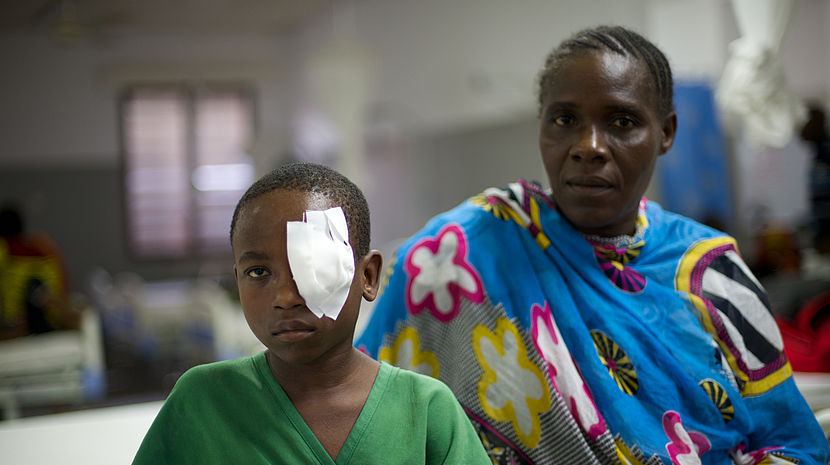15.09.2015 Trachoma outreach camps targetting Uganda’s poorest communities

This is a guest post which initially appeared on CBM UK‘s blog, written by Andrea Brandt von Lindau, CBM UK’s Trachoma and Eye Health Programme Officer.
CBM has been running Trachoma outreach camps in Uganda since October last year. I recently had the opportunity to visit a CBM Trachoma outreach camp in Uganda.
The camp lasted for one week and clearly involved a great deal of planning and preparation. Staff from CBM’s local partner organisation, the Benedictine Eye Hospital, based in Tororo, spent each day in a different local health centre in the target sub-district, where they set up an operating theatre for the day. TT surgeons from the local district, who were trained by our programme, operated all of the Trachoma patients who attended the camp each day. Patients returned the following day to have their bandages removed and to be given eye drops with instructions of how to look after their eyes. Surgery patients were also given antibiotics to prevent reoccurrence of the infection.
One major logistical challenge during these outreach camps is patient mobilisation, not only in terms of finding patients and encouraging them to seek help, but also transporting them to the outreach site and back home. CBM uses radio adverts and the ‘town crier’, a car with loudspeakers which drives around the villages and makes public announcements to make people aware of an upcoming Trachoma camp. In addition, CBM has started using so-called ‘case finders’, a method which has proved extremely successful. In Uganda, case finders are usually members of existing Village Health Teams, who are trained to inform people about different health issues and possibilities for treatment and/or prevention.
CBM’s Trachoma programme has trained a number of case finders to make an initial Trachoma diagnosis and counsel people to encourage them to seek treatment. The latter can be extremely challenging because people are often suspicious or fearful of undergoing surgery. However, now that the Trachoma outreach programme has been running successfully for some time, people hear more and more success stories from former patients. As a result, more new patients are now coming forward for surgery. All patients will also receive counselling at the camp itself where they are being told about what the surgery entails and where they can ask questions. Some people will still refuse surgery at the camp, but this is usually a small minority. CBM also provides transport for patients who live too far from the health centre to walk there and who can’t afford transport, which again increases patient numbers.
The outreach camps also see a large number of patients who do not have Trachoma but all kinds of other eye problems. Some issues, e.g. allergies, can be treated with eye drops; however, many other patients require further treatment such as Cataract surgery. This has created a significant need to complement the trachoma camps with Cataract surgery camps. Currently, Cataract patients’ details are recorded so they can be notified the next time a Cataract camp is held. In future, Trachoma and Cataract camps could be organised concurrently, meaning that Cataract patients would no longer have to wait for treatment. In any case, the treatment of other eye diseases is of course extremely important, not only to help as many people as possible, but also to maintain people’s trust in the programme and ensure that patients keep attending. The saddest thing to see is when patients attend the camp who have already suffered irreversible sight loss through diseases like Glaucoma and who have to be told that they cannot be helped. These patients are also referred to the counsellor who will explain the difference between their problem and those of other patients who can be helped.
Something else that struck me is how many people had other disabilities, in addition to Trachoma. This could be other eye issues like Cataract or physical disabilities. One elderly man whose bandages were removed following his Trachoma surgery told us he still couldn’t see anything, due to Cataract. He will now be added to the list of patients who will be alerted the next time CBM will hold a Cataract outreach camp in the area which could be several months later. Benyamen, an Ophthalmic Assistant who screened patients at the camp, talked about meeting a number of elderly women from some remote villages at a recent Cataract camp, who, in addition to having Cataracts, were unable to walk, and had never accessed health services before.
At the Trachoma camp, we met Joyce who is unable to walk and therefore very reliant on her daughter in her every-day life. Her daughter had found out about the camp from a local case finder and the camp vehicle picked Joyce up from her home. It is good to know that she has now received the surgery which will save her from going blind, as this would have made her mobility issues even worse; however, as a disability organisation, I feel that CBM should be providing support for her physical disability too, and was glad to hear that our project team is currently sourcing a wheelchair for Joyce.
CBM will continue to conduct TT surgery in Uganda. This work is complemented by the distribution of antibiotics which prevent the infection and other organisations working to improve water and hygiene standards. The ultimate aim is to eliminate Trachoma in Uganda.